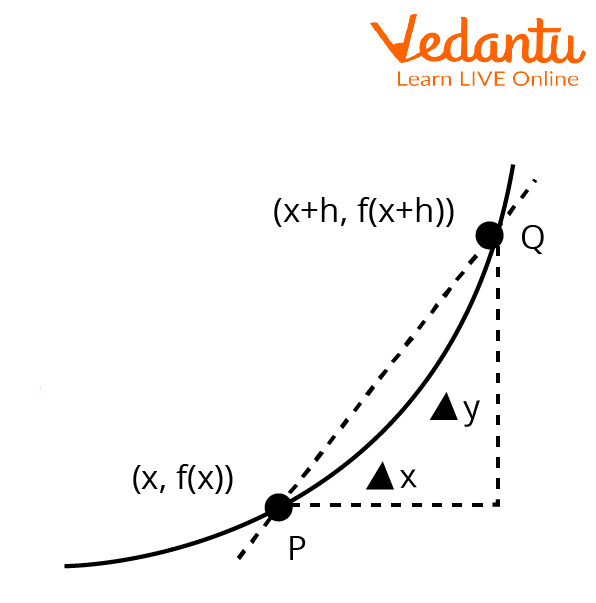




How to Apply Differentiation Theorem in Problem Solving
Theorems on differentiation specifically the sum, difference, product, and quotient rules are used in solving problems and finding the required solution. Here, we will discuss such fundamental theorems on differentiation with their detailed Proof. Differentiation is a fundamental tool of calculus and is also used as an alternative to the slope of the curve. In this article, we will learn and discuss some important theorems on differentiation. This will be followed by some solved examples for better understanding and clarity.
How to Define Differentiation?
Differentiation is defined as a derivative of a function with respect to an independent variable. Consider $y=f(x)$ be a function of $x$. Then, the rate of change of " $y$ " with respect to any change in " $x$ " is given as: $\dfrac{dy}{dx}$.
Mathematically,
$f(x)=\underset{h \rightarrow 0}{\lim}\dfrac{f(x+h)-f(x)}{h}$

Differentiation Graph
History of Mathematician
There were many mathematicians associated with differentiation. However, the definition of differentiation was given by Issac Newton.

Isaac Newton
Name: Isaac Newton
Born: 4 January 1643
Died: 31 March 1727
Field: Mathematics and Science
Nationality: England
Theorems and Proofs of Differentiation
1. Sum or Difference Rule
$\dfrac{d}{d x} f(x) \pm g(x)=\dfrac{d}{d x} f(x) \pm \dfrac{d}{d x} g(x)$\
2. Sum Rule
The derivative of the sum of two functions is the sum of the derivatives of the functions.
$\dfrac{d}{d x} f(x) \pm g(x)=\dfrac{d}{d x} f(x) \pm \dfrac{d}{d x} g(x)$
Proof:
By the definition of derivatives,
$\dfrac{d}{d x} f(x)+\dfrac{d}{d x} g(x)=\underset{h \rightarrow 0}{\lim} \dfrac{f(x+h)-f(x)}{h}+\underset{g \rightarrow 0}{\lim} \dfrac{g(x+h)-g(x)}{h}$
Take the RHS,
$\qquad R H S=\underset{h \rightarrow 0}{\lim} \dfrac{f(x+h)-f(x)+g(x+h)-g(x)}{h} \\
=\underset{h \rightarrow 0}{\lim} \dfrac{f(x+h)+g(x+h)-[f(x)+g(x))]}{h} \\
=\dfrac{d}{d x}[f(x)+g(x)] \\ =\text { LHS }$
Hence Proved.
3. Difference Rule
The derivative of the difference between two functions is the difference between the derivatives of the functions.
$\dfrac{d}{d x}[f(x)-g(x)]=\dfrac{d}{d x} f(x)-\dfrac{d}{d x} g(x)$
Proof:
By the definition of derivatives,
$\dfrac{d}{d x} f(x)-\dfrac{d}{d x} g(x)=\underset{h \rightarrow 0}{\lim} \dfrac{f(x+h)-f(x)}{h}-\underset{g \rightarrow 0}{\lim} \dfrac{g(x+h)-g(x)}{h}$
Take the RHS,
$R H S=\underset{h \rightarrow 0}{\lim} \dfrac{[f(x+h)-f(x)]-[g(x+h)-g(x)]}{h} \\ =\underset{h \rightarrow 0}{\lim} \dfrac{f(x+h)-g(x+h)-[f(x)-g(x))]}{h} \\=\underset{h \rightarrow 0}{\lim} \dfrac{f(x+h)-f(x)}{h}-\dfrac{g(x+h)-g(x)}{h} \\$
$=\dfrac{d}{d x}[f(x)-g(x)]$
$=$ LHS
Hence Proved.
4. Product Rule
The derivative of the product of two functions is given by the Product Rule.
$\dfrac{d}{d x}[f(x) g(x)]=\left[\dfrac{d}{d x} f(x)\right] g(x)+\left[\dfrac{d}{d x} g(x)\right] f(x)$
Proof:
By the definition of derivatives,
$\dfrac{d}{d x}[f(x) g(x)]=\underset{h \rightarrow 0}{\lim} \dfrac{f(x+h) g(x+h)-f(x) (g(x)}{h}$
By using the limit properties
$\underset{h \rightarrow 0}{\lim} f(x+h) \dfrac{g(x+h)-g(x)}{h}+\underset{h \rightarrow 0}{\lim} g(x) \dfrac{f(x+h)-f(x)}{h} \\\Longrightarrow\left[\underset{h \rightarrow 0}{\lim} f(x+h)\right] \left[\underset{h \rightarrow 0}{\lim} \dfrac{g(x+h)-g(x)}{h}\right]+\left[\underset{h \rightarrow 0}{\lim} g(x)\right] \\\left[\underset{h \rightarrow 0}{\lim} \dfrac{f(x+h)-f(x)}{h}\right] \\=\left[\dfrac{d}{d x} f(x)\right] g(x)+\left[\dfrac{d}{d x} g(x)\right] f(x)$
Hence Proved.
5. Quotient Rule
The derivative of the quotient of two functions is given by the Quotient Rule.
$\dfrac{d}{d x}=\dfrac{\left[\dfrac{d}{d x} f(x)\right] g(x)-\left[\dfrac{d}{d x} g(x)\right] f(x)}{g(x)^{2}}$
Proof:
By the definition of derivatives
$\underset{h \rightarrow 0}{\lim} \dfrac{\dfrac{f(x+h))}{g(x+h))}-\dfrac{f(x))}{g(x))}}{h}$
$\Rightarrow \underset{h \rightarrow 0}{\lim} \dfrac{1}{h} \dfrac{f(x+h) g(x)-f(x) g(x)+f(x) g(x)-f(x) g(x+h)}{g(x+h) g(x)} \\\Rightarrow \underset{h \rightarrow 0}{\lim} \dfrac{1}{g(x+h) g(x)} \\=\dfrac{f(x+h) g(x)-f(x) g(x)+f(x) g(x)-f(x) g(x+h)}{h} \\\Rightarrow\left[\underset{h \rightarrow 0}{\lim} \dfrac{1}{g(x+h) g(x)}\right] g(x) \dfrac{f(x+h)-f(x)}{h}-f(x) \dfrac{g(x+h)-g(x)}{h}$
By using the limit properties
$\Rightarrow \dfrac{1}{\underset{h \rightarrow 0}{\lim} g(x+h) g(x)} \left(\left[\left(\underset{h \rightarrow 0}{\lim} g(x)\right) \underset{h \rightarrow 0}{\lim} \dfrac{f(x+h)-f(x)}{h}\right]-\left[\left(\underset{h \rightarrow 0}{\lim} f(x)\right)\right.\right. \\\left.\left. \underset{h \rightarrow 0}{\lim} \dfrac{g(x+h)-g(x)}{h}\right]\right) \\\Rightarrow \dfrac{1}{g(x) g(x)}\left(g(x) f^{\prime}(x)-f(x) g^{\prime}(x)\right.$
$\Rightarrow \dfrac{f^{\prime} g-f g^{\prime}}{g^{2}}$
Hence Proved.
6. Constant Rule
The derivative of the constant functions is zero.
$\dfrac{d}{d x}(c)=0$
Proof:
Here $f(x)=c$, by the definition of the derivative, we have
$f^{\prime}(x)= \underset{h \rightarrow 0}{\lim} \dfrac{f(x+h)-f(x)}{h} \\ \Longrightarrow \underset{h \rightarrow 0}{\lim} \dfrac{c-c}{h} \\ \Longrightarrow \underset{h \rightarrow 0}{\lim} 0=0$
7. Power Rule
$\dfrac{d}{d x} x^{n}=n x^{n-1}$
Proof:
Assume $n$ to be a positive integer.
The binomial theorem states that
$(a+b)^{n}=a^{n}+n a^{n-1} b+\dfrac{n(n-1)}{2 !} a^{n-2} b^{2}+\cdots \ldots n a b^{n-1}+b^{n}$
where,
$\left(\begin{array}{l}k \\n\end{array}\right)=\dfrac{n !}{k !(n-k) !} \\n !=n(n-1)(n-2) \ldots . .(2)(1)$
From the definition of derivatives and using the binomial theorem
$\Rightarrow f^{\prime}(x)=\underset{h \rightarrow 0}{\lim} \dfrac{(x+h)^{n}-x^{n}}{h} \\\Rightarrow \underset{h \rightarrow 0}{\lim} \dfrac{x^{n}+n x^{n-1} h+\cdots \cdot}{h} \\\Rightarrow f^{\prime}(x)=\underset{h \rightarrow 0}{\lim} \dfrac{n x^{n-1}+\dfrac{n(n-1)}{2 !} x^{n-2} h^{2}+\cdots \ldots n x h^{n-1}+h^{n}}{h} \\\Rightarrow f^{\prime}(x)=\underset{h \rightarrow 0}{\lim} n x^{n-1}+\dfrac{n(n-1)}{2 !} x^{n-2} h+\cdots \ldots n x h^{n-2}+h^{n}-1 \\=n x^{n-1}$
Hence Proved.
8. Chain Rule
$\dfrac{d}{d x} f(u(x))=\left[f^{\prime} u(x)\right] \dfrac{d u}{d x}$
9. Rolle’s Theorem
Rolle's Theorem states that if $\mathrm{f}$ is a function that satisfies:
$f$ is continuous on the closed interval $\left[a, b\right]$,
$f$ is differentiable on the open interval $(a, b)$, and
$f(a)=f(b)$
Then there exists a point $c$ in the open interval $(a, b)$ such that $f^{\prime}(c)=0$.
Solved Examples
1: Find $\dfrac{dy}{dx}$ of
$f(y)=\left(3 x^{3}-2 x^{2}\right)\left(4 x^{5}+x^{2}\right)$
Ans:
$\dfrac{d}{d x}\left(\left(3 x^{3}-2 x^{2}\right)\left(4 x^{5}+x^{2}\right)\right)$
Apply the Product Rule: $(f \cdot g)^{\prime}=f^{\prime} \cdot g+f \cdot g^{\prime}$
$\Rightarrow f=3 x^{3}-2 x^{2}, g=4 x^{5}+x^{2} \\\Longrightarrow \dfrac{d}{d x}\left(3 x^{3}-2 x^{2}\right)\left(4 x^{5}+x^{2}\right)+\dfrac{d}{d x}\left(4 x^{5}+x^{2}\right)\left(3 x^{3}-2 x^{2}\right)$
Apply the Sum/Difference Rule: $(f \pm g)^{\prime}=f^{\prime} \pm g^{\prime}$
$\Longrightarrow \dfrac{d}{d x}\left(3 x^{3}\right)-\dfrac{d}{d x}\left(2 x^{2}\right)$
$\Rightarrow \dfrac{d}{d x}\left(3 x^{3}\right)$
Apply the Power Rule: $\dfrac{d}{d x}\left(x^{a}\right)=a \cdot x^{a-1}$
$\Rightarrow 3 \cdot 3 x^{3-1}$
$\Longrightarrow 9 x^{2}$
$\Rightarrow \dfrac{d}{d x}\left(2 x^{2}\right)$
$\Rightarrow 2 \cdot 2 x^{2-1}$
$\Longrightarrow 4 x$
So,
$\Rightarrow \dfrac{d}{d x}\left(3 x^{3}\right)-\dfrac{d}{d x}\left(2 x^{2}\right) \\\Rightarrow 9 x^{2}-4 x \\\Rightarrow \dfrac{d}{d x}\left(4 x^{5}+x^{2}\right) \\\Rightarrow \dfrac{d}{d x}\left(4 x^{5}\right)+\dfrac{d}{d x}\left(x^{2}\right) \\\Rightarrow 20 x^{4}+2 x \\\Rightarrow\left(9 x^{2}-4 x\right)\left(4 x^{5}+x^{2}\right)+\left(20 x^{4}+2 x\right)\left(3 x^{3}-2 x^{2}\right) \\\Rightarrow 96 x^{7}-56 x^{6}+15 x^{4}-8 x^{3}$
2: In the mean value theorem, $f(b)-f(a)=(b-a) f^{\prime}(c)$ if $a=9, b=16$ and $f(x)=\sqrt{x}$ then what is the value of $c$ ?
Ans:
$F(x)=\sqrt{x}$
$\therefore f(a)=\sqrt{9}=3, f(b)=\sqrt{16}=4 ; f^{\prime}(x)=\dfrac{1}{2} \sqrt{x}$
Also, $f^{\prime}(c)=\dfrac{[f(b)-f(a)]} {[b-a]}=\dfrac{[4-3]}{16-9}=\dfrac{1}{7}$
$\therefore \dfrac{1}{2\sqrt{c}}=\dfrac{1}{7} \quad C=\dfrac{49}{4}=12.25$
Example 3: If the function $f(x)=x^{3}-6 x^{2}+a x+b$ satisfies Rolle's theorem in the interval $[1,3]$ and $f^{\prime}\left(\dfrac{2 \sqrt{3}+1}{\sqrt{3}}\right)=0$, then find the value of $a$.
Ans:
$f(x)=x^{3}-6 x^{2}+a x+b \\ \Rightarrow f^{\prime}(x)=3 x^{2}-12 x+a \\ \Rightarrow f^{\prime}(c)=0 \\ \Rightarrow f^{\prime}\left(2+\dfrac{1}{\sqrt{3}}\right)=0 \\ \Rightarrow 3(2+\sqrt{3})^{2}-12\left(2+\dfrac{1}{\sqrt{3}}\right)+a=0 \\ \Rightarrow 3\left(4+\dfrac{1}{3}+4 \sqrt{3}\right)-12\left(2+\dfrac{1}{\sqrt{3}}\right)+a=0 \\ \Rightarrow 12+1+4 \sqrt{3}-24-4 \sqrt{3}+a=0$
Now we get
$\Rightarrow a=11$
Conclusion
In this article, we have discussed the theorems on differentiation and their proofs. The proof, statement, and examples are thoroughly explained above. From the discussion above about the theorem on differentiation, we can conclude that they are very useful theorems to be used in solving calculus questions.
Important Differentiation Formulas to Remember
$\dfrac{d k}{d x}=0 \quad$ where $k=$ constant
$\dfrac{d(x)}{d x}=1$
$\dfrac{d(k x)}{d x}=k \quad$ where $k=$ constant
$\dfrac{d\left(x^{n}\right)}{d x}=n x^{n-1}$
Important Points to Remember
Concept of Differentiation, how to define differentiation must be studied in depth.
Differentiation is a synonym of slope.
FAQs on Differentiation Theorem: Meaning, Proofs & Applications
1. What are the fundamental theorems of differentiation that are essential for solving calculus problems?
The fundamental theorems of differentiation are a set of rules used to find the derivative of a function. The key theorems covered in the CBSE syllabus include:
- The Sum/Difference Rule: The derivative of a sum or difference of functions is the sum or difference of their derivatives.
- The Product Rule: Used to find the derivative of a product of two functions.
- The Quotient Rule: Used for finding the derivative of a function that is the ratio of two other functions.
- The Power Rule: A simple method for differentiating functions of the form xn.
- The Chain Rule: Essential for differentiating composite functions (a function within a function).
- Rolle's Theorem: A special case of the Mean Value Theorem that identifies points where a function's tangent is horizontal.
2. How is the concept of a derivative different from the slope of a line?
While related, a derivative and a slope have a key difference. The slope measures the steepness of a straight line and is constant everywhere on that line. In contrast, a derivative gives the slope of a curve at a specific point. It represents the instantaneous rate of change of the function at that point. For a curved graph, the derivative's value changes from point to point, unlike the constant slope of a straight line.
3. Why can't we just multiply the derivatives of two functions to find the derivative of their product?
Simply multiplying the derivatives of two functions, say f(x) and g(x), is incorrect because it fails to account for how each function's change affects the other. The Product Rule, which states that (f·g)' = f'·g + f·g', is necessary because the total change in the product f(x)g(x) depends on two things: how fast f(x) is changing (f') multiplied by g(x), and how fast g(x) is changing (g') multiplied by f(x). Forgetting one of these components leads to an incorrect result.
4. What are some practical, real-world applications of differentiation theorems?
Theorems on differentiation are not just academic; they have significant real-world applications across various fields:
- Physics: To calculate instantaneous velocity and acceleration from a displacement function.
- Business and Economics: To determine marginal cost and marginal revenue, helping companies maximise profit.
- Engineering: In optimisation problems, such as finding the dimensions for a container that will minimise material cost for a given volume.
- Medicine and Biology: To model the rate of growth of tumours or the rate of change in population sizes.
5. Can you explain the Quotient Rule using a simple example?
The Quotient Rule is used to differentiate functions that are a fraction of two other functions, say f(x)/g(x). The formula is: (f'/g - f·g') / g².
For example, let's find the derivative of h(x) = (x²) / (sin x).
Here, f(x) = x² and g(x) = sin x. Their derivatives are f'(x) = 2x and g'(x) = cos x.
Applying the rule:
h'(x) = [ (2x)·(sin x) - (x²)·(cos x) ] / (sin x)²
This demonstrates how the rule systematically finds the derivative of a ratio.
6. Why is a differentiable function always continuous, but a continuous function is not always differentiable?
This is a core concept in calculus. A function is differentiable at a point if it has a well-defined, non-vertical tangent line, meaning the curve is smooth. For a curve to be smooth, it must be connected, which is the definition of continuity. However, a function can be continuous (unbroken) but not differentiable if it has a sharp corner or a cusp. For example, the function f(x) = |x| is continuous at x=0, but you cannot draw a unique tangent there, so it is not differentiable at that point.
7. What does Rolle's Theorem tell us about a function's graph?
Rolle's Theorem provides a specific insight into a function's behaviour. It states that if a function is continuous and differentiable over a closed interval [a, b], and the function's values at the endpoints are equal (f(a) = f(b)), then there must be at least one point 'c' between a and b where the derivative is zero (f'(c) = 0). Graphically, this means that if a smooth curve starts and ends at the same height, it must have at least one point in between where the tangent line is perfectly horizontal.
























